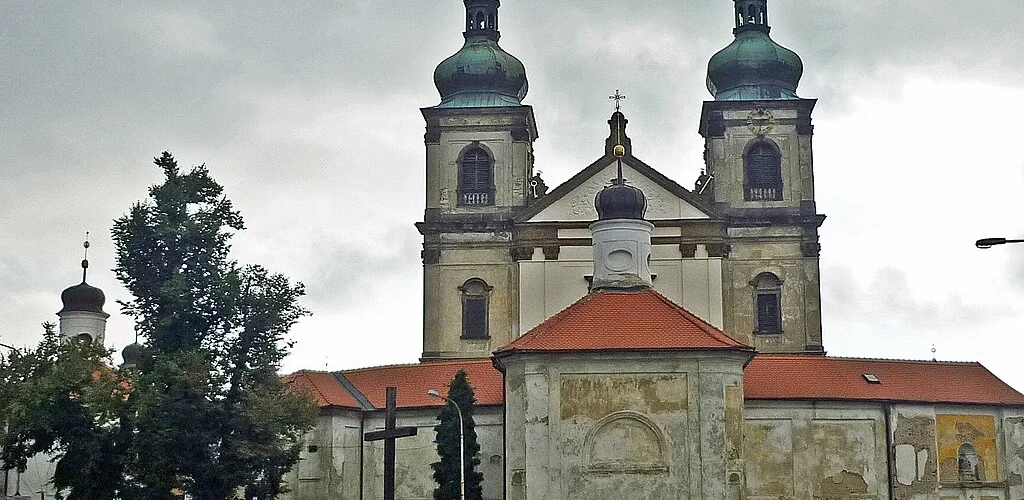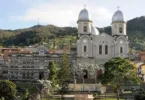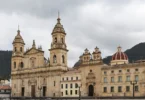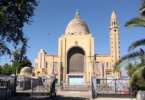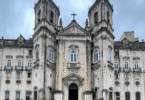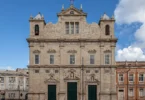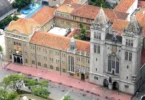Introduction
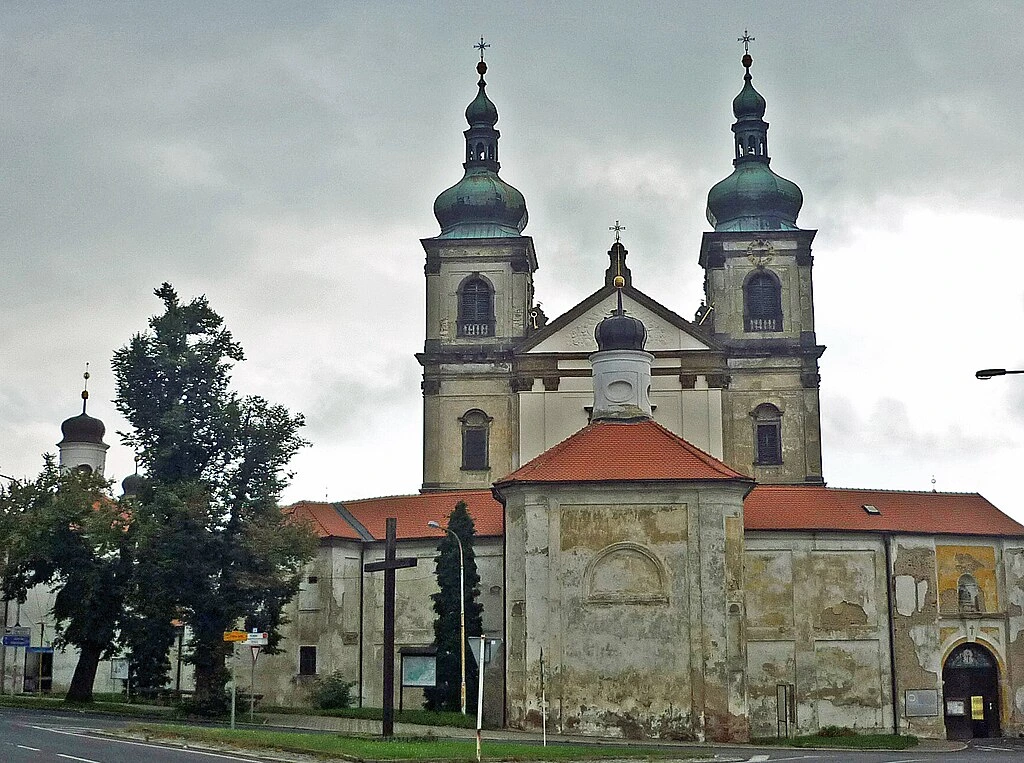
The Basilica of Our Lady of Sorrows in Bohosudov, located in the heart of the city, is a significant pilgrimage site in North Bohemia. It has long been a place of devotion, drawing pilgrims from far and wide. By the early 20th century, in 1911, it was the second most visited pilgrimage site in the Litoměřice diocese and the fifth in all of Bohemia. Before the construction of the Basilica in Filipov in 1885, it held the title of the most visited Marian shrine in North Bohemia. Pilgrims continue to come here, with a special tradition involving around 500 Sorbs from neighboring German Lusatia who visit annually. The history of the site dates back to 1426, when a small chapel, possibly made of wood, was first built. It was expanded in 1507, but by 1620, the building had fallen into disrepair. In the early 17th century, between 1621 and 1624, it was rebuilt. The construction of the current basilica began in 1701 under the direction of architects Giulio and Octavio Broggio, and the church was completed in 1708, with the addition of the two towers in the western façade. Recognized as a cultural monument since 1964, it was officially declared a national cultural monument of the Czech Republic in 2018, underscoring its importance in both religious and historical contexts.
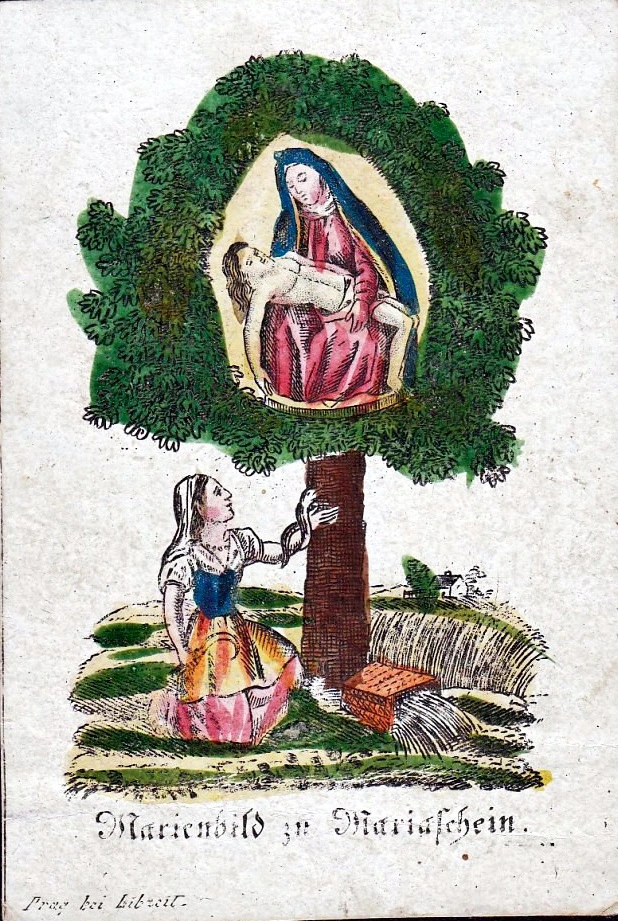
Legend
In the cloister of the Bohosudov Basilica, wall paintings from 1701-1706 depict the legend of the origin of this pilgrimage site. Since 1227, there was a monastery of the Sisters of the Guardians of the Holy Sepulchre in nearby Světec u Bílina . This monastery was attacked and burned by the Hussites. Some of the nuns escaped while others were killed. When they fled, the sisters took with them the most valuable object of their monastery – a small statue of the Virgin Mary of Sorrows, which had long been devoutly worshipped. The nuns hid out in the forests near Bohosudov and eventually gave in to the challenges of living a difficult and unusual life there. The last of them, as depicted in the cloister, hid the statuette in a hollowed-out old linden tree just before she died, according to legend. On the feast of the Nativity of the Virgin Mary in 1425, a girl from nearby Krupka came to these locations to mow the grass. The legend does not specify how long the statuette was hidden in the linden tree. There was also a spring near the linden tree. However, the girl was suddenly attacked by a poisonous snake (usually understood in the biblical sense as a symbol of the devil), which wrapped itself around her bare hand. The girl screamed and dropped the sickle. Instead of attacking, the snake turned towards the linden tree and began to hiss unusually loudly. Suddenly, completely paralyzed, it fell down and, without harming the girl, disappeared into the grass. This scene is depicted in the cloister of the basilica. The girl ran home and related this incredible tale. Her employer saw that this was an extraordinary event and, after consulting with some of the townspeople of Krupka , he went with them to the old linden tree. During its inspection, they found a statue of the Sorrowful Virgin Mary in the hollow . After consulting with the Krupka parish priest, a procession was taken from Krupka to the linden tree, which carried the statue to the Krupka parish church . However, the statue disappeared from the Krupka church and was eventually found again in a hollowed-out linden tree. According to legend, pious individuals constructed the first wooden chapel here when this occurred once more.
After the defeat of the crusader army on June 16, 1426, in the Battle of Na Běháni near Ústí nad Labem, many crusaders died while fleeing at the site of the future Bohosudov. The courthouse in Bohosudov was also destroyed, and then Krupka in 1429. Six years later, the courthouse was restored and a chapel was built nearby in memory of the fallen crusaders and in honor of the Virgin Mary of Sorrows . This chapel then housed the aforementioned Gothic love statue. At the time, the water in the nearby well was already regarded as curative. However, literary sources do not rule out that the statue of love could have been in the monastery of the Guardians of the Holy Sepulchre in Světec. The nuns could have found refuge in the Rosenberg Castle above Krupkou when they fled from Světec. From there, the statue could have reached the wooden chapel built later.
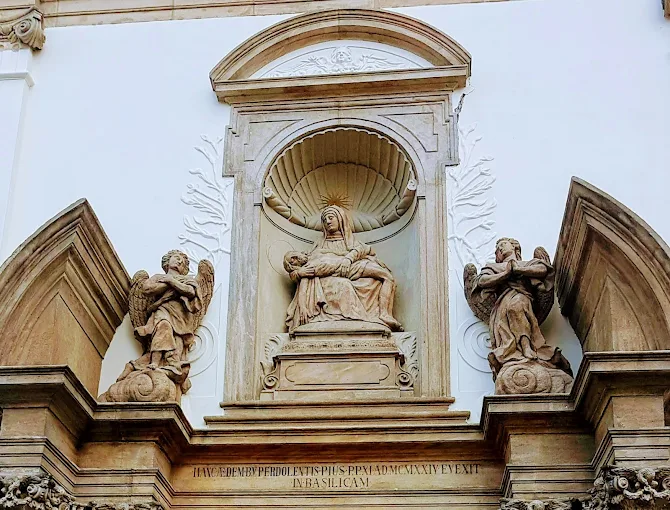
Statue of Our Lady of Sorrows
The Gothic love statue of Our Lady of Sorrows is made of unidentified fired clay and stands about 15 centimeters tall. It shows the Virgin Mary sitting down with the crucified Christ on her lap and gazing at him in agony. The statue, whose artistic value is not very great, was so damaged over the centuries that in 1709 it was covered with a protective gold sheet. The original wooden chapel was soon replaced by a stone one. Already in 1503 there is evidence that the Supreme Chancellor Albrecht of Kolovrat was a great admirer of this love statue and was responsible for the first period of prosperity of this pilgrimage site. In 1507, the chapel was expanded and made into a pilgrimage church. Pilgrims to the “local” Virgin Mary in Rome received full indulgences personally from Albrecht of Kolovrat. On October 14, 1515, the church was dedicated. Around 1618 it fell into disrepair and was rebuilt in the years 1621 – 1624 and then burned down. The current church was built in the years 1701 – 1708 by the Litoměřice builders Giulio and Octavio Broggi.
The Reformation and Thirty Years’ War
Throughout the Reformation, Bohosudov’s church remained Catholic and helped local Catholics fight for Protestantism. Processions from far away began to arrive soon. An example is the procession from Zittau, from where pilgrims had been coming regularly since 1515. However, the church was in serious jeopardy in 1576 when Krupka and Zittau both converted to Protestantism. In 1584, Emperor Rudolf II. handed over the Franciscan monastery in Krupka, along with this church, to the strictly Catholic George of Lobkowicz . He had the church restored and was responsible for its new flourishing. In 1587, the church of Bohosudov was handed over to the Jesuits by St. Clement of Prague , who became the creators of the glory of this pilgrimage site. The number of pilgrims to Bohosudov increased every year, so that in 1644 , 34 priests had to confess there on the feast of the Nativity of the Virgin Mary , four of whom were Jesuits from the Chomutov college . All pilgrims to the Virgin Mary of Bohosudov received seven-year plenary indulgences from Pope Paul V as early as 1615. After the outbreak of the Thirty Years’ War, which was started by the Czech anti-Habsburg uprising, this promising development was interrupted.
The Chomutov rector of the Jesuit college secretly transported the statue of love to Duchcov after the government of directors expelled the Jesuits from Bohemia in 1618. It was the statue’s first hiding place during the Thirty Years’ War. The Bohosudov church was subsequently devastated. The statue remained in Duchcov until 1624, despite the Jesuits’ return to Bohosudov in 1621. During the Swedish invasion, the statue had to be concealed once more. In 1631, it was taken to Prague, where it remained until 1635. Due to the fact that the Swedish army once more pillaged the church in Bohosudov, this was a wise decision. In the meantime, when there was relative peace during the Thirty Years’ War, the Jesuits in Bohosudov tried to carry out extensive missionary counter-reformation activities. The statue had to be hidden from the Swedes for the third time in 1639. It was taken to Chomutov , where it remained until 1640. When the Swedes defeated the imperial side in the bloody Battle of Breifenfeld , the Swedish army under the command of Lennart Torstenson in 1642 again to Bohemia and the statue was moved for the fourth time , again to Chomutov. After that, it was returned for a short time, only to be hidden for the last time, the fifth time during the Thirty Years’ War, so that in the years 1643 – 1651 it was kept in Chomutov. After that, it returned permanently to Bohosudov.
Revival and Expansion During the Baroque Period
After the Thirty Years’ War, the church in Bohosudov saw a real revival, largely thanks to a generous legacy from Anna Maria Regnierová von Bleyleben, who left her estate in Soběchleb to the church. The “old building,” a new Jesuit residence, was built in 1652 thanks to this donation, which enabled construction to begin. But that structure was soon outgrown, so a larger Jesuit residence was built in 1677, along with a school for singers and altar boys. The Jesuits really brought new life to the church, and pilgrimages to Bohosudov grew year after year. Maxmilián Rudolf Schleinitz, the first Bishop of Litomice, urged people to visit this significant location by 1675. His successor, Bishop Jaroslav Ignác Šternberk, also took the church under his wing and supported its growth. As the old church couldn’t handle the growing number of pilgrims, plans were made for a new one. They laid the foundation stone for the new church on July 3, 1701, and by September 1, 1706, the church was consecrated, with a ceremony bringing the statue of Our Lady of Sorrows into it. The construction didn’t stop there, though. In 1722, they finished building the oval cloister, which was surrounded by seven chapels. Towns and individuals who had visited the site and wanted to contribute purchased these chapels. They included chapels from places like Zákupy (1684-1688), Teplice (1671-1672), Litoměřice (1688), Bleyleben (after 1665), Kolovrat (1693), Osek (1722), and Duchcov (1625). Each chapel featured paintings of the seven sorrows of the Virgin Mary. It was a busy time for the church, with pilgrims flocking in and the buildings growing to accommodate them.
Pilgrimages and processions
Not only pilgrims, but also the statuette traveled four more times because it had to be hidden. This took place in 1706, when another Swedish invasion threat arose. The statuette was transported to Prague as a result. During the Seven Years’ Austro-Prussian War, it was in Chomutov in 1756 and in Litoměřice in 1762. In the end, it was once more hidden in Litomice during the War of the Bavarian Succession in 1779. Bohosudov reached its peak in pilgrimage in the 18th century . In 1709, 29,000 pilgrims received Holy Communion in September alone, and 68,700 for the whole year . With 100,000 sacraments received annually, the peak was reached in 1720. In order to avoid crowding the pilgrimage site, even individual processions from various locations had to be scheduled in advance. In addition, pilgrims frequently traveled here to Krupka, which is nearby, to view the Holy Stairs replica there.
Healing and answering prayers
The first pilgrimages to Bohosudov were motivated by numerous miraculous healings and prayers that were answered, but systematic records of extraordinary answers only date back to 1671. During a sermon in 1706, a total of 1,500 answered prayers and miraculous healings were reported. These phenomena became more numerous. For example, more than 500 answered prayers of pilgrims are recorded for 1721. In Bohosudov, there were also conversions from Protestantism to the Catholic faith, sometimes even among prominent figures of the time.
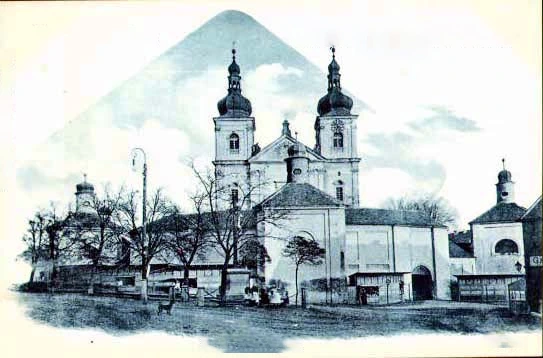
Period of Josephinism and revival
When the Jesuit order was abolished in 1773 , there were 14 Jesuits in Bohosudov. The church was in danger of disappearing, especially after 1782 , when Joseph II. banned all pilgrimages and processions. At that time, the Bishop of Litoměřice Ferdinand Kindermann intervened by founding an independent locality in Bohosudov in 1786 , which was promoted to a provostship in 1798. The old pilgrimage glory was revived again at the beginning of the 19th century , and in 1802 , 115 thousand people received Holy Communion there. In 1853 , the Jesuits returned to Bohosudov and remained there until 1950 , when they were interned by the communist regime as part of Action K. The Jesuits in Bohosudov again established their schools, a private grammar school with a student boarding house (the so-called small seminary ), from which many priests active in the Litoměřice diocese graduated. In 1855, a new seminary building was therefore built. The entire complex was significantly expanded in 1905 and 1912-1913, bringing the total number of inmates to nearly 400. The Jesuits were active here not only as protectors of the pilgrimage site, but also as educators, organizers of folk missions , Marian congregations, Jesuit retreats and other spiritual programs.
Basilica minor
On June 6, 1924, Pope Pius XI issued a special breve, elevating the church of Bohosudov to a minor basilica, prior to the alleged 500th anniversary of the establishment of the Bohosudov pilgrimage site in 1925. According to the papal breve, the church of Bohosudov is a significant Marian shrine in Bohemia. The brief also talks about the church’s equipment, basilica privileges, and indulgences. It also includes pilgrimages and the hearing of supplications and miracles. The elevation to a minor basilica was requested by the rector of the Jesuit college in Bohosudov and was recommended by both the general prosecutor of the Society of Jesus and the bishop of Litoměřice, Josef Gross. Although the number of pilgrims who received the sacrament in Bohosudov decreased in the first half of the 20th century , around 30 thousand of them still came annually.
Architecture of Basilica of Our Lady of Sorrows, Krupka, Czechia
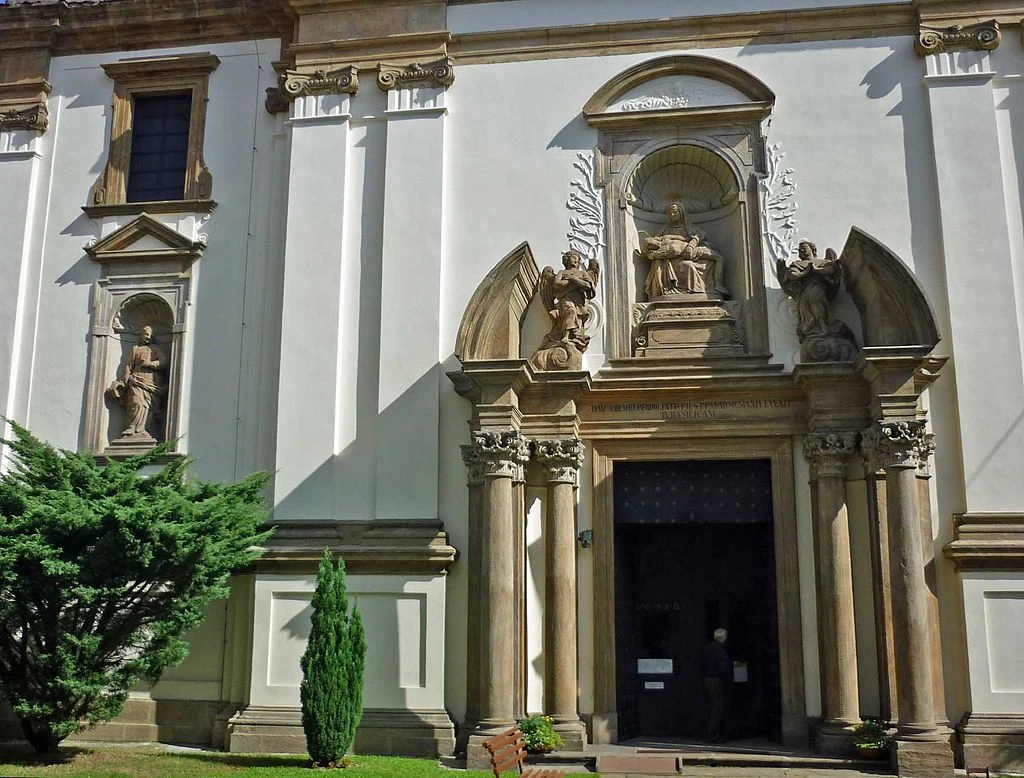
Architectural style: Baroque architecture
Exterior
As you walk up to the basilica, the first thing you’ll notice is how massive and solid it feels. It’s a single-nave building rectangular in shape with three pairs of side chapels tucked in along the walls. At the front (the western side), there are two big, blocky towers standing tall. The presbytery at the back is rounded off in a semi-circle. The outside of the building is broken up by pilasters (those flat, column-like things on the wall), and the windows are either rounded or rectangular, some with little curved or triangular decorations on top. The western façade the front you walk up to is really something. There’s a thick cornice splitting it between floors, and the middle section ends in a sharp triangular gable. Right in the center, there’s a dramatic entrance framed by composite columns and pilasters, topped with what’s called a “supraporta” basically an upper decorative element. Inside that, there’s a niche with a sculpture of the Pieta that’s Mary holding the body of Jesus surrounded by stucco and angel statues. The outside of the church is full of detailed sculptural work by Franz Tollinger, done around 1705. You’ll see statues of Jesuit saints on the facade and northern wall, along with statues of St. Peter and St. Paul. Over on the south side, there are figures of four Czech patron saints.
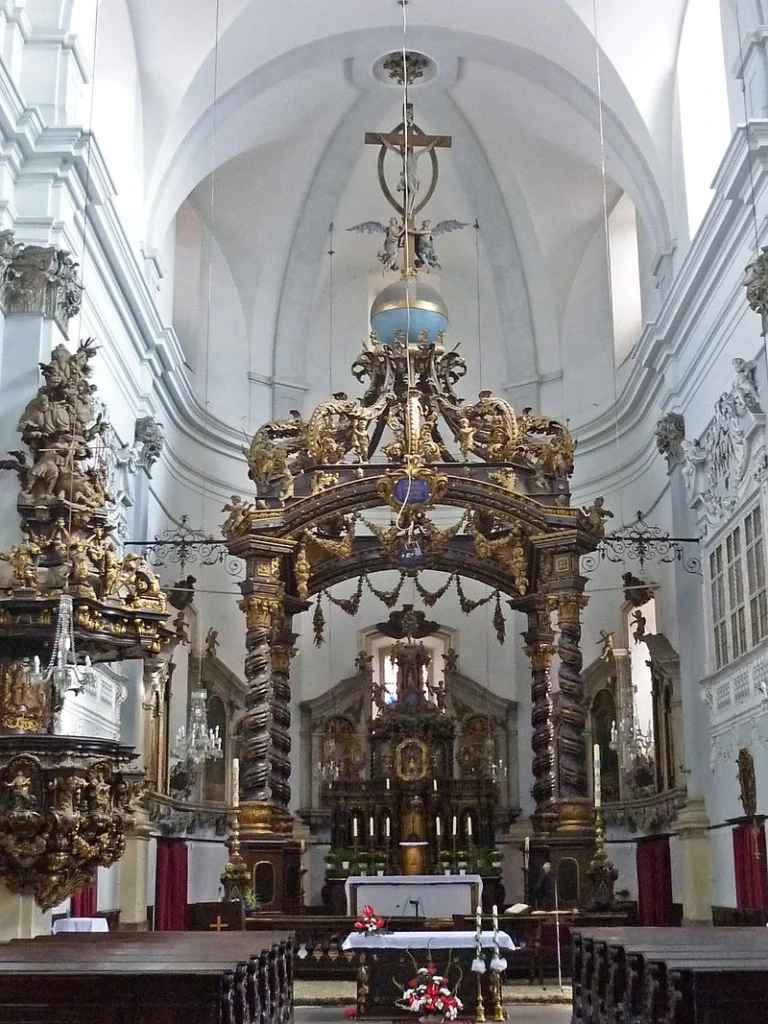
Interior
Step inside, and the layout feels balanced and clean. The space is broken up by pilasters again, which separate the side chapels. The main part of the church the nave has a barrel-vaulted ceiling with little window-like openings called lunettes. Everything’s made of brick, but it feels warm and grand.
Main Altar & Equipment
The main altar stands under a baldachin kind of like a canopy held up by four spiraled columns, each wrapped with decorative garlands. At the very top, there’s a statue of Christ standing on a globe. The altar itself is double-sided, with carved saints in little niches and along the top cornice. This whole setup was done by Tollinger too, between 1707 and 1714. Most of the side altars are original Baroque pieces tall, columned, and rich in detail. Newer statues were added later by a sculptor from Prague named E. Veselý.
Side Altars
One altar is dedicated to St. Anne, with paintings of her and Mary Magdalene. These are flanked by low-relief panels made by the so-called “Master of Teplice.” There’s another altar for St. John of Nepomuk, with paintings by Ignaz Raab, including a picture of Christ in an oval frame above. Same goes for the altars of St. Barbara and St. Joseph each has two paintings: one of the saint and one of Christ or another figure in an extension above. Again, most of this artwork was done by Raab. There are also twin altars for St. Ignatius and St. Francis Xavier. These were painted in 1712 by Jan Jiří Heinsch. Their design is similar to the main altar but simpler. The Francis Xavier altar is sort of a matching piece to the Ignatius one, and both still have their original Baroque statues standing freely in front.
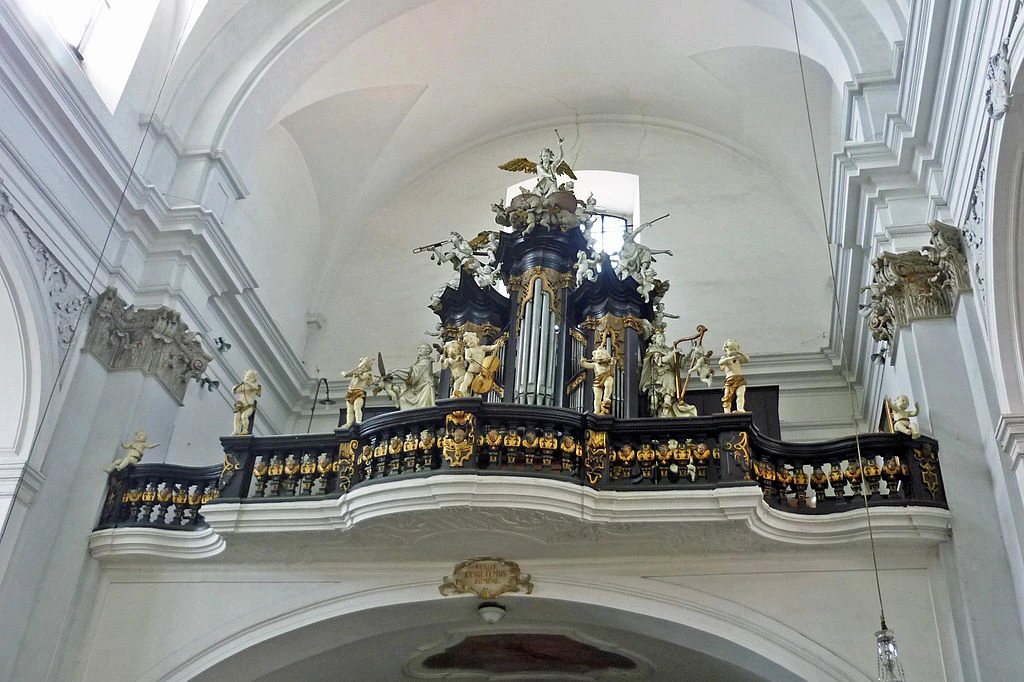
Other equipment
In the chapel of St. Francis Xavier, there’s a painting of the saint and a tombstone for a man named Ladislav Przichowski. The pulpit, which is probably another work by Tollinger from 1714, is full of carved detail. On top of it, there’s a dramatic sculpture showing the conversion of St. Paul. Below the gallery on the west wall, you’ll find two big Baroque confessionals from the mid-1700s they’ve got spinning columns, painted saint medallions, and little angel figures. All the side chapels also have confessionals, carved with flat reliefs showing scenes from Jesus’s life. These were probably made around 1735 by the Master of Teplice. The organ, from 1734, sits in a fancy carved wooden case, decorated with statues of King David and St. Cecilia both tied to music. At the very top, there’s a group of angels playing instruments. More angel statues can be found all along the upper gallery rail. Even the benches are worth a look they’re Baroque too, with carved sides, dating from around 1730. In front of the main altar, there are big Baroque candlesticks and a heavy bronze chandelier, both from 1693.
Bells
Back in the day, the basilica had at least eight bells spread between the two towers and the sacristy. Today, only two are left. In the north tower, there’s one made by Matěj Špic in 1541 with a Czech inscription. In the sacristy, there’s another from 1713 by Jan Baltazar Crommel. The wooden frame that holds them was built in 1923. Up in the lantern of the south tower, there are two small hour-chiming cymbal bells shaped like little bells.
Chapel Above the Spring
Between the basilica and the left cloister, there’s a smaller, peaceful little chapel built right above the spring. It’s a Baroque building from 1722 with a square base and simple, solid lines. The corners are marked by pilasters, and it’s topped with a dome that has a small cylindrical lantern and an onion-shaped roof classic Baroque. The windows and the entrance are rounded at the top (they call it “segmental”), and there’s a triangular gable over the main door. Not huge, but it has a quiet charm to it.
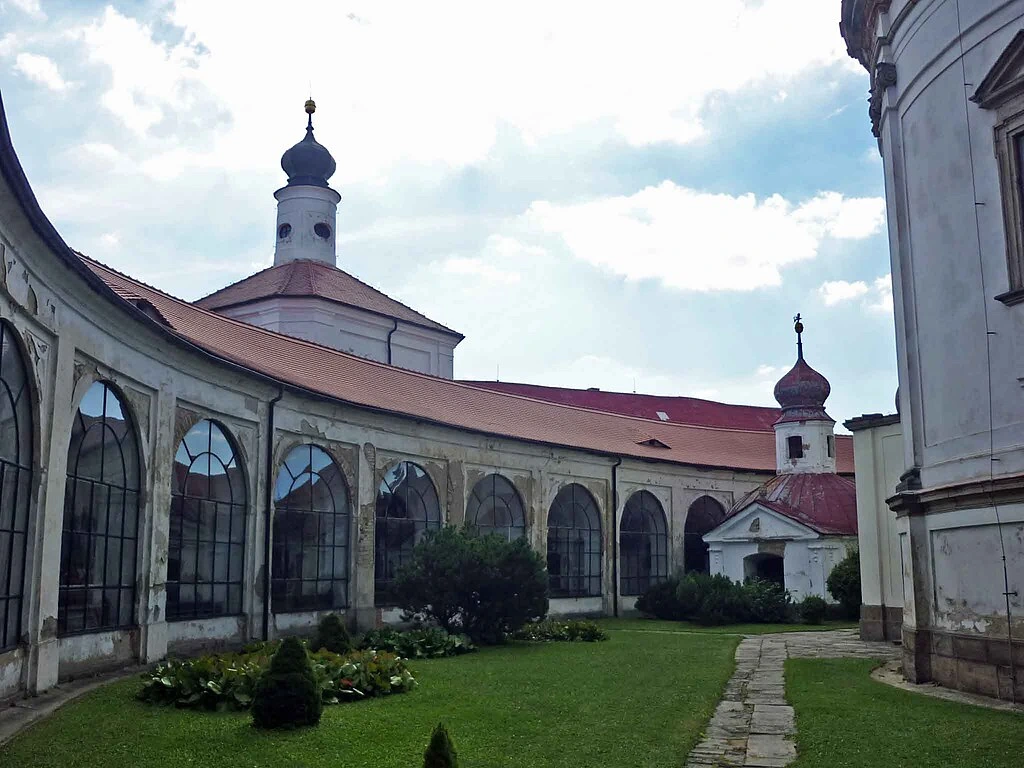
Cloisters
The True Cloister (Left Cloister)
Wrapped around the basilica is an oval-shaped cloister with chapels set into the walls. The original cloister was built way back between 1584 and 1594, back when it was there to protect the old Gothic church that stood on the spot. Even then, it already had seven chapels. Over time, the area around the walls filled up with more pilgrimage chapels. The outer wall was eventually turned into a covered walkway basically a passageway with arches resting on pillars, letting people walk through into the courtyard. The ceiling is built with cross vaults, and in its current form, it was finished in 1722 by architect O. Broggio. Inside the cloisters, you’ll find frescoes that tell stories from the history of the Bohosudov pilgrimage site real pieces of the past painted right onto the walls.
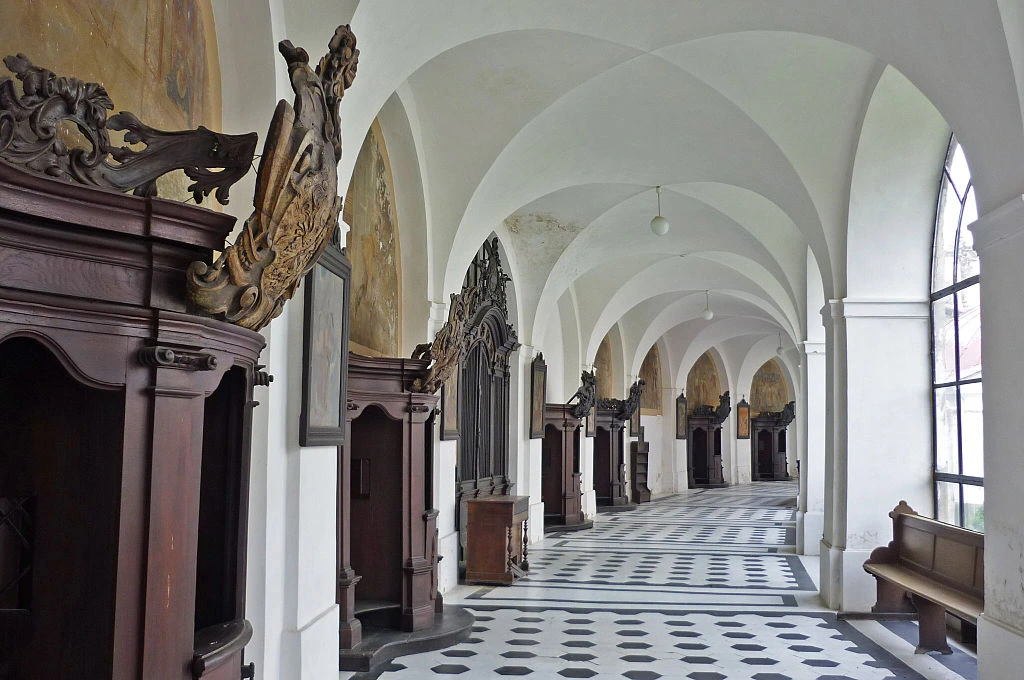
Pilgrimage Chapels Inside the Cloisters
Zákupy Chapel
Built between 1684 and 1688, this chapel was fixed up again in 1857. The altar inside came from a chapel in the Horní Polič castle and features a painting of The Flight into Egypt. There’s also a statue of St. Wenceslas from the late 1700s. The entrance is closed off by an elegant wrought iron gate, decorated with flowers and a coat of arms.
Teplice Chapel
This one goes back to 1671–1672. Inside, there’s a stucco altar with a painting of Finding Jesus in the Temple. On the side walls, framed in stucco, are two more paintings Adoration of the Shepherds and Laying in the Tomb. Like the others, it has a beautifully detailed Baroque grille with floral patterns. Between the Teplice and Litoměřice chapels, there’s a niche with a colorful wooden sculpture of the Virgin Mary (known as the Assumpta), made sometime in the mid-1700s. Flanking her are four statues of the Evangelists, standing freely on either side.
Litoměřice Chapel
Built in 1688, this chapel features an altar with spiral columns and a painting of the Stations of the Cross. There’s another niche between this one and the Bleyleben Chapel, holding a striking Gothic wooden carving from the early 1500s, showing the Ecce Homo scene Christ presented to the crowd. On both sides are small Baroque angel figures (putti), some standing in little niches and others on the walls.
Bleyleben Chapel
This chapel started construction shortly after 1655. It has a Baroque tombstone and saint statues tucked into wall niches beside the altar. It’s a bit more subdued but still rich in old-world detail.
Kolovrat Chapel
Built in 1693, this chapel holds a side altar from the early 1600s originally part of the old pilgrimage church. The altar is flanked by composite columns and small niches. At its center is a Pieta (Mary holding Jesus after the crucifixion), with statues of St. Peter and St. Paul beside it. Above the altar, there’s a dramatic scene of the Holy Trinity surrounded by four saints. Sculptures of saints also stand freely in niches along the walls. The iron gate is topped with the Kolovrat family’s emblem, dated 1719. From this chapel to the main entrance, there are 11 Baroque confessionals all carved in the late 1600s.
Osek Chapel
A simpler one, this chapel was built in 1722.
Duchcov Chapel
Built in 1625 and rebuilt almost a century later in 1721. Inside, you’ll find statues of St. Veronica and St. Helena standing on wall brackets. Like many of the other chapels, this one is also fitted with an ornate wrought iron gate.
Jesuit Residence Architecture
The oldest part of the Jesuit residence goes back to 1650. Originally, it served as housing for clergy and wealthier pilgrims. Later, when the new residence was built, the old building was turned into a school first for choir and Latin, then it became the main school building. It’s right next to the cloisters, connected by a decorated staircase. The building has four wings and two floors, and while it’s part of the basilica complex, it doesn’t stand out artistically. It’s functional, more than anything.
Chapel on the Pilgrimage Route to Stará Boleslav
There’s also a chapel that was part of the pilgrimage route from Prague to Stará Boleslav. It was built sometime between 1674 and 1690 and was dedicated to Our Lady of Krupecká, also known locally as Our Lady of Bohosudov.
Feast Day
Feast Day : 15 September
The Basilica of Our Lady of Sorrows in Krupka, Czechia celebrates its feast day on September 15. This date honors Our Lady of Sorrows, reflecting on the seven sorrows of the Virgin Mary. It’s a significant day for the church and often marked by special Masses and local pilgrimage traditions.
Church Mass Timing
Monday to Saturday : 10:00 AM
Sunday : 9:00 AM, 10:00 AM, 5:00 PM .
Church Opening Time:
Monday & Thursday : Closed.
Tuesday to Saturday : 9:00 am – 3:30 pm
Sunday : 10:00 am – 3:30 pm
Contact Info
Address : Basilica of Our Lady of Sorrows in Bohosudov
Koněvova 100, 417 42 Krupka 1, Czechia.
Phone : +385 51 452 900
Accommodations
Connectivities
Airway
Basilica of Our Lady of Sorrows, Krupka, Czechia, to Václav Havel Airport Prague (PRG), distance 1 hr 12 min (101.3 km) via D8.
Railway
Basilica of Our Lady of Sorrows, Krupka, Czechia, to Krupka Railway Station, distance between 3 min (1.8 km) via Route 253.

